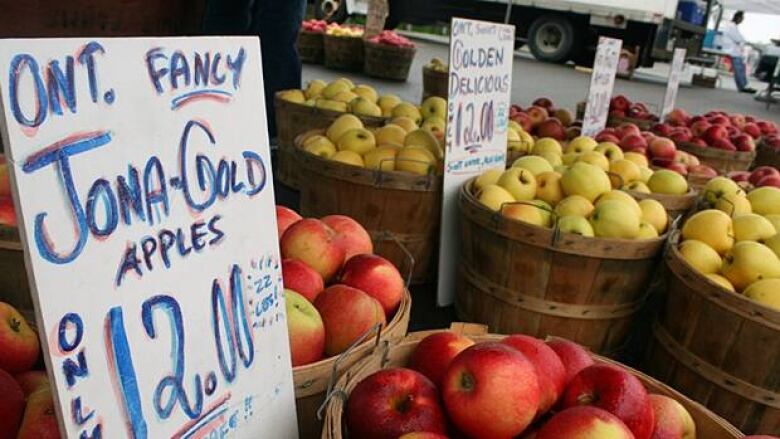Can Hamilton feed itself?

Some of Canada’s most fertile and productive agricultural land lies in the Hamilton area.
But getting the diverse local offerings into the hands of Hamiltonians is no easy task.
"We live in an area where food is abundant in terms of it being grown all around us," says Sarah Wakefield, co-chair of a city food security subcommittee. "We have the best climate in Canada, basically, for growing fruits and vegetables. But the issue is always about distribution."
Grocery store chains favour large-scale farms feeding into the mass distribution chain, though many stores now feature pockets of local produce on their shelves.
How much Hamilton food gets into the city’s grocery stores and farmer’s markets is unknown, but Wakefield says numerous small initiatives are percolating with the hope of feeding a growing demand.
"So many of them are new," says Wakefield, a Hamiltonian who co-chairs the City of Hamilton Community Food Security Stakeholder Committee. "There’s so much momentum in Hamilton in just the past four or five years."
Wakefield is one of the organizers trying to create a food network that hopes to bring all the groups together and get more local food into Hamilton kitchens and businesses.
But even if a network could be created, it couldn't fill all of Hamilton needs.
A University of Toronto graduate student recently wrote a research paper on the hypothetical question: can Hamilton’s 133,000 acres of farmland feed its population?
What Lisa Ohberg found was that it would currently be impossible.
Local produce overall could only potentially feed 35 per cent of Hamilton’s food needs, according to her theoretical calculations based on estimates of food production in the area using 2006 census data, the latest figures available. The amount rose to half for just the city’s milk needs and three-fifths for meat, but dropped to one third for fruits and vegetables.
"If we can’t [be locally sustainable], then nowhere in Canada could be," says Wakefield.
Ohberg isn’t the only one who’s looked to Hamilton for signs that a local food network of some sort is viable.
Agri-food think-tank George Morris Centre took a close look at the combined Hamilton and Niagara areas with that same question in mind.
'There’s so much momentum in Hamilton in just the past four or five years.' —Sarah Wakefield
"It’s a good question," says Martin Gooch, director of value chain management at the centre who wrote a 256-page study in 2009 study on the topic.
But despite unique microclimates in the region that allow it to produce nearly half of Ontario’s fruit and a diverse range of produce, Gooch is skeptical about local food networks. Local food devotees, Gooch warns, are often "blinded by their own desires and aspirations."
Imported food is often "marketed better, marketed prettier and often marketed at a higher quality, it’s kept better and handled better," he says.
He laments that farmers aren’t thinking strategically to compete with the global market.
As an example, he cites apple farmers packaging their large, higher-quality apples together to get a premium price rather than mixing the produce.
Another is the lack of refrigerator trucks on the field to keep the freshly picked produce out of the wilting sun, as California producers do.
"This is a historical thing," said Gooch. "We producers in Canada tend to by and large tend to be slower to adopt innovation."
Organizations in other cities have succeeded in creating small distribution hubs, Gooch says. In Winnipeg, Fresh Options distributes to chefs, institutions, retailers, stores and residents.
Other examples include large distributors such as Gordon Food Service, which includes local food in its Ontario distribution.
Farmer and president of the Hamilton-Wentworth Federation of Agriculture Roy Shuker takes a more practical approach.
"If there’s a place for it, some entrepreneur would take it on if he could make a dollar at it," says Shuker.
Ultimately, Gooch says the market needs to respond to the consumer — and he's not sure local is really top of consumer priorities.
"What people often say is not what they do," says Gooch.
Recent research by the centre showed that while shoppers vehemently expressed support for local, hardly any of them had local produce in their cart at the grocery store exit, he says.
How the fruit or vegetables taste and look is higher on their list of priorities, he says. "If you get those right, then local becomes a differentiating factor," says Gooch.
Local food proponent Sarah Wakefield isn’t letting a few problems stand in her way. She believes the diversity of local food initiatives in the Hammer is the result of a sense of "shared adversity."
"We’ve seen the rise and fall of the steel mills and the economic problems that came along with that," she says. "There’s a real sense that people have this shared identity in Hamilton."
And she’s banking on that.